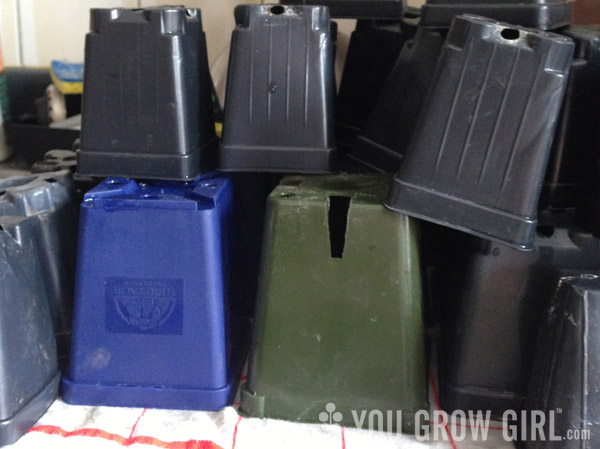
You’d be surprised by what can qualify as a decent, if not great, seed starting pot and perhaps surprised even more to discover that many can be found in the recycling bin. Toilet rolls are free and accessible, but have their downside. I can get a second use from the paper cups and cartons that my to-go cappuccinos and milk come in. Large yoghurt containers are the perfect size and depth for flourishing seedlings that need a little more space before transplanting outside, and plastic packaging of all sorts can be cut up and repurposed into handy self-watering containers.
My Favourite Seed Starting Containers
With a few exceptions, I prefer to start my seeds in a pot that is large enough to carry them through from seed, to seedling, to their final place, whether that will be in the ground or in a pot outdoors.
My reasons for this are 1. I grow a lot of plants from seed and repotting hundreds of plants is not work that I want to do. 2. My eyes are always bigger than my space and starting seeds in their final pot gives me a clear indication of how many seedlings I can reasonably grow within my space. Were I to start in peat pots (hate them) or soil blockers, or some other super tiny little nugget of soil, I can guarantee you that I would over sow and be out of optimal space underneath lights in 2-4 weeks. Sowing in the way that I do keeps me in check.
I have a few favourite containers that I hoard and reuse over and over again. Most of them were acquired when I bought or received seedlings from friends. There are different pots for different plants, depending on their growth habit and needs. For herbs, dwarf tomatoes, hot peppers, and a few other miscellaneous plants, I love small 2 1/2″ X 3 1/2″ black pots that taper down toward the end. This tapering increases drainage. For plants that grow very slowly, lettuces, and herbs that do not develop deep root systems or require extra drainage, I often turn to the square pots that are approximately 3 1/4″ wide and deep. These pots are not tapered and do not drain as well. For tomatoes, sweet peppers, cucumbers, and a host of other deeply-rooted edibles I favour the standard 3 1/4″ x 4″ pots (often called 4″ pots) that most seedlings come in at the store.
I rarely have need to purchase a container for seed-starting, but when I do, I like these plastic drinking cups from the dollar store. They are nice and deep and great for most tomatoes. They do require that I add drainage holes, but once that’s done I can get a good 5+ years of use from them.
Washing Containers
I do not wash all of my seed starting containers every year. I wash newly acquired containers because I don’t always know where they’ve been and what has been in and on them. I thoroughly wash containers that may have had diseased or pest-laden plants in them. And every few years I scrub away any salt deposits that have formed around the drainage holes and tops of the pots. In other years, I simply wipe away any old soil with a rag, brush, or my fingers.
To Disinfect: Most garden literature suggest soaking pots in a mild bleach solution, but I don’t use bleach or like to keep it in the house so I wash my pots in warm, soapy water a few splashes of hydrogen peroxide (aka oxygenated bleach) added. You can buy this in the cleaning product section of most health food stores.
Solid Plan! If only the world had a few more responsible-minded people like yourself, we’d probably in such a healthier & more efficient place. ^_^
I know exactly what you mean about filling up the space under the grow lights. Right now I am bursting at the seams with seedlings. Poor planning and over-eager tendencies. There are scads of potted bulbs waking up, also trying to squeeze into the party.
I detest those peat pots, too. They are more adept at wicking much-needed moisture away from the root ball than they are at decomposing.
I also reuse plastic pots in great numbers for early spring seed starting and transplanting. I am forced to store my pots outside which shortens their lifespan considerably, but the in-flow of pots (through plant purchases or donations from friends) seems to be adequate. I do buy propagation trays every few years, the 3-piece kind with the water reservoir and the felt liner to carry water to the seedling cells. Not all seedlings like that very wet situation, though.
I agree. The self-watering trays really only work for some plants.
I use individual yogurt containers to get seedlings started, which has been pretty successful this year.